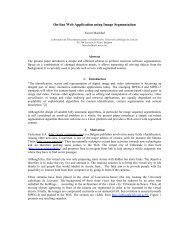motion estimation and compensation for very low bitrate video coding
motion estimation and compensation for very low bitrate video coding
motion estimation and compensation for very low bitrate video coding
Create successful ePaper yourself
Turn your PDF publications into a flip-book with our unique Google optimized e-Paper software.
Introduction 7<br />
MPEG-4 st<strong>and</strong>ard which adds a new dimension to <strong>video</strong> <strong>coding</strong> as it<br />
o ers the possibility to separately encode the di erent objects of a scene<br />
<strong>and</strong> there<strong>for</strong>e interact with these objects at the decoder end.<br />
Time-varying image sequences can be compressed by independently <strong>coding</strong><br />
each frame (intra-frame image <strong>coding</strong>) or by extending spatial <strong>coding</strong><br />
techniques to the time dimension (e.g. 3D trans<strong>for</strong>m <strong>coding</strong>). However,<br />
the main characteristic of a <strong>video</strong> sequence is precisely its spatiotemporal<br />
component: most of the in<strong>for</strong>mation in an image sequence is<br />
the result of <strong>motion</strong>. A lot of e ort has there<strong>for</strong>e been put into <strong>motion</strong><br />
analysis of <strong>video</strong> sources. The range of applications of such an analysis<br />
includes, but is not limited to, automatic tracking of targets, piloting<br />
of robots, events detection <strong>for</strong> surveillance, tridimensional reconstruction<br />
of objects, image restoration... In a <strong>video</strong> <strong>coding</strong> context, <strong>motion</strong><br />
analysis is mainly used to reduce the inter-image redundancy: instead<br />
of <strong>coding</strong> e<strong>very</strong> new frame on its own basis, references are searched <strong>for</strong><br />
in the previously coded image. On a practical point of view, it means<br />
that one searches <strong>for</strong> parts of the new picture which are already present<br />
in the previous frame <strong>and</strong> which have just undergone some movement.<br />
Once the <strong>motion</strong> parameters have been estimated <strong>and</strong> transmitted to<br />
the decoder, their application provides a <strong>very</strong> good prediction of the<br />
new image. This technique, referred to as \<strong>motion</strong> <strong>estimation</strong> <strong>and</strong> <strong>compensation</strong>",<br />
achieves one of the most important compression factor in<br />
a <strong>video</strong> coder thanks to its radical reduction of the spatio-temporal redundancy.<br />
Since underst<strong>and</strong>ing image <strong>for</strong>mation is a prerequisite <strong>for</strong> fully grasping<br />
the methods to recover <strong>motion</strong> in<strong>for</strong>mation from images, Chapter<br />
Two starts with a short description on how images are generated <strong>and</strong><br />
how the real tridimensional <strong>motion</strong> of objects results in <strong>motion</strong> on the<br />
bidimensional picture plane. Chapter Two simultaneously presents the<br />
phenomena that can disturb or prevent a correct <strong>motion</strong> <strong>estimation</strong>,<br />
<strong>and</strong> stresses the ill-posed nature of the problem. The chapter provides<br />
a Rate-Distortion justi cation of the use of <strong>motion</strong> <strong>estimation</strong> in <strong>video</strong><br />
coders <strong>and</strong> introduces the various models <strong>and</strong> methodologies that can<br />
constitute the basis of di erent <strong>motion</strong> algorithms. Classical <strong>and</strong> emerging<br />
<strong>motion</strong> <strong>estimation</strong> techniques developed <strong>for</strong> image <strong>coding</strong> purposes<br />
are detailed <strong>and</strong> the two of them (namely the Block-Matching Algorithm,<br />
BMA, <strong>and</strong> Image Warping technique) which are used in the present work<br />
conclude the chapter.<br />
More largely, the present thesis mainly deals with <strong>motion</strong> <strong>estimation</strong> <strong>and</strong>





